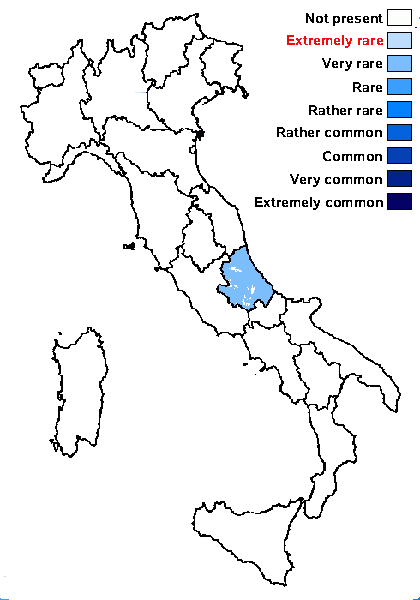Peccania tiruncula (Nyl.) Henssen
in Henssen & Jørgensen, Lichenologist, 22: 143, 1990. Basionym: Omphalaria tiruncula Nyl. - Flora, 61: 338, 1878.
Synonyms: Thyrea tiruncula (Nyl.) Zahlbr.
Distribution: C - Abr (Nimis & Tretiach 1999).
Description: Thallus foliose-subsquamulose, peltate-monophyllous, 180-300 μm thick, attached by a single central strand of rhizohyphae, dull black to dark brown when dry, dark olive-brown when wet, the squamules 1-2(-3) mm wide, 1-1.5 mm high, with initially erect then parallel to the substrate, densely crowded, subcylindrical to flattened, 0.2-0.3 mm thick, mostly simple lobules. Thallus ecorticate, the peripheral part 40-65 μm thick, with a loose network of anticlinally oriented hyphae enclosing the photobiont, the inner part with an irregular, 100-170 μm thick axial strand made of longitudinally to irregularly oriented hyphae. Apothecia marginal or subterminal, 1-2 per squamule, at first urceolate then clearly lecanorine, 0.4-0.8(-1) mm across, round to irregular in outline, with a dark orange-brown, slightly concave to flat, often finally fissured disc and a thick, prominent thalline margin. Proper exciple absent; epithecium yellowish brown, poorly differentiated; hymenium colourless, but with conspicuous brown to red-brown patches in the upper third, 80-110 μm high, I+ blue; paraphyses branched and anastomosing, 2-4 μm thick, not constricted at septa, clearly capitate; hypothecium yellowish brown, 60-90 μm high (higher in central part). Asci 8-spored, broadly clavate, thin-walled, with a distinct gelatinose, amyloid outer cap, but no apical dome, Peccania-type. Ascospores 1-celled, hyaline, globose or subglobose, 8-10(-12) x 7-9(-11) μm. Pycnidia immersed, globose to pyriform, unilocular, 180-230 x 40-65 μm. Conidia 1-celled, hyaline, thread-like, curved, 20-35 x c. 1 μm. Photobiont cyanobacterial, chroococcoid, with single or paired 10-17 x 8-14 μm large cells often penetrated by haustoria, surrounded by a yellowish brown gelatinous sheath which tends to become thinner and paler in internal parts. Spot test: all negative. Chemistry: without lichen substances. Note: a poorly known species of exposed calcareous rocks, which deserves further study, apparently more widespread in subsaharan Africa (Algeria, Morocco), and also known from Turkey .
Growth form: Fruticose
Substrata: rocks
Photobiont: cyanobacteria, coccaceous (e.g. Gloeocapsa)
Reproductive strategy: mainly sexual
On otherwise dry surfaces with short periods of water seepage after rain
Poorly known taxon in need of further study
Commonnes-rarity: (info)
Alpine belt: absent
Subalpine belt: absent
Oromediterranean belt: absent
Montane belt: very rare
Submediterranean belt: very rare
Padanian area: absent
Humid submediterranean belt: absent
Humid mediterranean belt: extremely rare
Dry mediterranean belt: extremely rare

Predictive model
Herbarium samples
Growth form: Fruticose
Substrata: rocks
Photobiont: cyanobacteria, coccaceous (e.g. Gloeocapsa)
Reproductive strategy: mainly sexual
On otherwise dry surfaces with short periods of water seepage after rain
Poorly known taxon in need of further study
Commonnes-rarity: (info)
Alpine belt: absent
Subalpine belt: absent
Oromediterranean belt: absent
Montane belt: very rare
Submediterranean belt: very rare
Padanian area: absent
Humid submediterranean belt: absent
Humid mediterranean belt: extremely rare
Dry mediterranean belt: extremely rare

Predictive model
| Herbarium samples |
 INDEX FUNGORUM
INDEX FUNGORUM
 GBIF
GBIF


